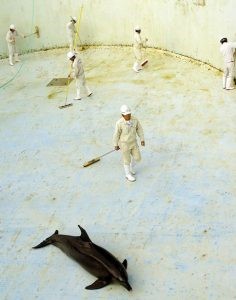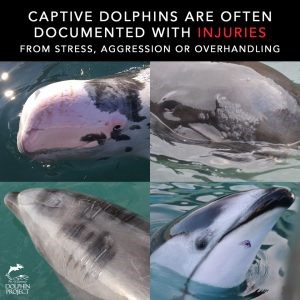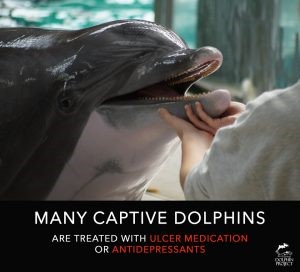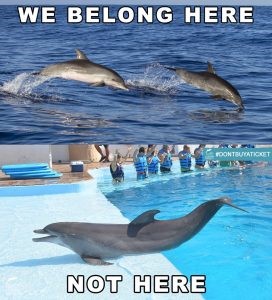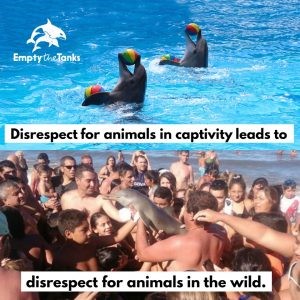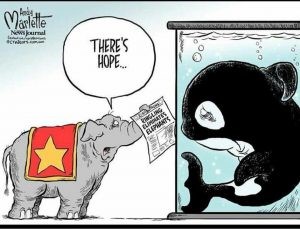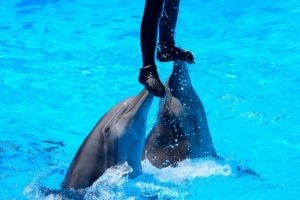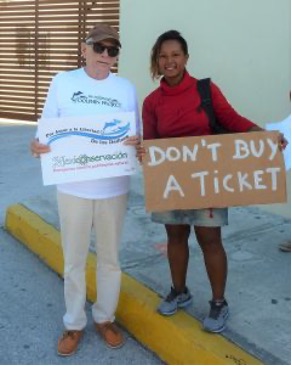Is swimming with dolphins on top of your list? READ THIS FIRST!
Do you know anybody who doesn’t like dolphins? Not me. Dolphins are intelligent, playful and they are super charismatic with their everlasting smile! But don’t be fooled. Dolphins don’t have facial muscles, so it only seems like they’re always smiling and happy. The only mistake from mother nature…
Flipper, the most famous dolphin of them all
Dolphins are mammals and belong to the cetacean family. There are about 40 species in the world, the most famous of which is the ‘great bottlenose dolphin’ (Tursiops Truncatus), more commonly known as ‘Flipper’, named after the 1960s TV series with the same name. In this series, five dolphins played the role of Flipper trained by Richard O’Barry. While the series was running, one of these dolphins died in the arms of its trainer. Richard was left with immense guilt. He was totally convinced that this dolphin had chosen to take his own life. Dolphins are very self-confident animals. They recognize themselves in a mirror and they also know very well when to swim to the surface of the water to breathe. The dolphin in question had chosen to stop breathing. The end for this dolphin, but unfortunately only the beginning of the great dolphin exploitation.
Due to the success of the series, more and more dolphinariums were created. In some regions such as the east coast of Yucatan where we are located, you will find a dolphinarium almost every 5km!!! ‘Swimming with Dolphins’ is also the best-selling tour in Cancun and the Riviera Maya. Yes, together these dolphinariums are visited more than the wonder of the world Chichen Itza! Understand who can understand. This activity may also be on your bucket list, but if you really love dolphins, don’t take part in the abuse of these poor animals.
Where do the captive dolphins really come from? Dolphinariums usually pretend that their dolphins were born on the spot. However, this applies to a small part of the animals. Most of the dolphins that entertain you were once wild and free. To meet the increasing demand, many of them are illegally kidnapped. The process of imprisonment is extremely cruel and violent. Dolphins are horribly separated from their families with whom they live closely together, which has a negative effect on the entire pod. Some dolphins are separated from the group, chased to exhaustion by speedboats to catch them in nets. The dolphins are already injured here and death by drowning is no exception. After this traumatic experience, they embark on a nerve-racking journey in small boats, locked trucks or airplanes, only to be dumped at their destination in a mini swimming pool. Here they often have to live together with other dolphins from another clan with whom they often do not match. In short, from the moment of the ‘kidnapping’, these poor animals live under a lot of stress.
What small pool? It’s bigger than the one from our resort!? ‘
When the pool needs to be cleaned, the water level goes down and the dolphins are stranded on the floor.
Dolphins in the wild cover daily distances between 60 and 160 km at 40 km/h and can dive to a depth of 90 m. This is impossible in the limited space they get in a dolphinarium. An average tank is 10 by 10 meters and often only 2 meters deep. This means that they can only swim in circles. Dolphins get mad and depressed in the small space they live in. Compare it to locking a person in a 2x2m loft. Wouldn’t you go crazy too? (I think the lockdown gave all us a taste of confinement, no?) At some dolphinariums they have built a small lake where the dolphins have more space, but this space is never enough! In addition, in many exotic destinations, these shallow pools heat up quickly, which is very unpleasant for the dolphins and can lead to death again. In nature, they would dive to cooler waters but that is not possible here. By the way, have you ever seen how they clean such a swimming pool with dolphins in it???? No pool or lake can ever be big enough to replace the ocean!!!
What small pool? It’s bigger than the one from our resort!? ‘
As humans, we are born with the natural urge to touch everything. However, you have to understand that dolphins and many other aquatic animals (sharks, sea turtles, fish,…) have a gelatinous protective layer on their skin that functions like snot in our nose. This layer can repel bacteria or toxic substances. However, our pH values are very acidic to them. Because a dolphin is touched by people all day long, this protective layer is damaged and great damage is caused.
But the opposite is also not good: dolphins can infect us with bacterial diseases such as salmonella. Dolphinariums certainly won’t inform people about the danger to your health… What they most likely do is add chlorine to their tanks to keep the bacteria level somewhat safe for humans. But you guessed it, this chlorine also causes significant damage to the skin and eyes of our dear friends. They can become completely blind. Is that touch really worth all this animal suffering? Learn to enjoy with your other four senses, find them in their habitat and keep your hands to yourself.
‘ But dolphins are well cared for and fed in dolphinariums, aren’t they? ‘
The dolphins are fed but how do you think they learn tricks? If they don’t kiss you, they get nothing on their plate, no reward, nothing, nada! Hunger is often facilitated so that their trick training remains effective. Frozen fish is on the menu of a captive dolphin and is only given if they do their job well. In the large ocean the dolphins go in search of fish themselves, which is healthier and going to hunt yourself also has a stimulating effect.
Dolphinariums often want to make it seem that dolphins live longer in confinement because they can intervene in the event of illness, for example, but this is also wrong. Dolphins can live 50 to 60 years in the wild. In captivity, there are many stillbirths and many live as little as 20 years. The dolphins are indeed treated with drugs for diseases, but they are usually diseases that they would never get in the wild. Studies have shown that captive dolphins are frequently given medication for stomach ulcers and depression, something they would never need in the wild. Dolphins (as well as killer whales) often exhibit self-destructive behavior in captivity. They refuse to breathe, jump out of their tanks, keep banging their heads against the walls… They are often so sad that they don’t wish their offspring the same fate. When a dolphin is born, the mother normally pushes her baby to the surface of the water so that the baby can take its first breath. Unfortunately, it often happens in dolphinariums that the mother refuses this because she does not want this life in captivity for her baby. Twenty years of working as a slave for someone’s entertainment without a day off, would you do it to your offspring?
‘ But it’s still educational ‘
‘ I was already in a dolphinarium and then they explained something completely different ’
Dolphinariums like to pretend to be centers of science and education, even as meccas for these poor creatures who would be nothing without them. They will try in every possible way to convince you that the dolphins that live here are happy and that they are well cared for. In some facilities, they even claim that the dolphins are released into the open sea in the evening and that they choose to come back the next day. However, dolphins are not chickens!
A lot of money is pumped into marketing and they are not averse to a lie. Slogans such as “For a better planet” evoke a lot of irony in our opinion. How can you make a better planet by using captive animals as slaves? Manatees and sea lions are often kept in such a dolphinarium that were rescued. These should boost the credibility of the dolphinarium. Saving and caring for animals is of course not negative, but these animals also often live in too small spaces and are often used for our entertainment. Taking an animal to a sanctuary because it has been hurt, or attempting to save a species from extinction is one thing but taking a perfectly healthy animal from its habitat to exploit for your entertainment is quite another… Learn the difference!
‘But swimming with dolphins is therapeutic, isn’t it? ‘
DAT or Dolphin Assisted Therapy is a program in which adults and children with autism, motor disorders or depression can be treated, so to speak, through the intervention of a dolphin. Betsy Smith was the founder of this program. In 1971 she saw positive results with her mentally retarded brother and started offering DAT for free in two dolphinariums in Florida. Other facilities saw the opportunity to make a ton of money with this and started offering DAT too.
However, in 2003, when Smith realized that this DAT was not improving the patients in the long term and that the dolphins were being exploited, she wisely decided to withdraw from this program. But dolphinariums are of course not going to inform us about this counter-study. If you are looking for animal therapy, give the person you wish to help rather a puppy from the shelter: you save an animal with it and it will give the same magical effect… Two birds, one stone. In addition, this puppy can share its entire life with you – not just a fleeting moment – which will have an effect over a much longer period of time.
‘ I can’t deny my children this experience, can I? ‘
Unless you’re that person who’s been living in a hole underground for years, you’ve run out of excuses. Twenty years ago you could still be ignorant, but with the invention of the internet and mobile phones, we now have all the information in our pocket. All the information is in that little device we stare at all day, no bigger than the palm of our hand… Use it for something useful and inform yourself! Or will you continue to claim that a dolphin’s nose is really made to lift your full body weight out of the water?
The only thing a dolphinarium wants from you is your money. Their concern for animals is pure show! This is big business, a multimillion-dollar business.
Richard O’Barry & Steffie de Man spreading awareness in Cancun.
Watch Richard O’Barry’s documentary “The Cove”. This 2009 Oscar-winning documentary tells the story of dolphin hunting in Taji, Japan. From here dolphins are sold worldwide to fill dolphinariums or as a snack at your beloved dolphin show.
But don’t make the same mistake Richard did. He’s been fighting for years to nullify the “Flipper” effect. On April 22, 1970, Richard launched his first campaign against captive dolphins. Richard is now 81 years old and still fights against the big dolphinariums around the world. Think before you start and avoid an eternal feeling of guilt! Don’t buy a ticket! Where there is no demand, the supply disappears!
Did this blog convince you not to go swimming with dolphins? Feel free to share with as many friends and family as possible. Together we can hopefully convince enough people to empty the tanks #emtythetanks.
Did this article make you think? Or a counterargument? Or better yet, do you know another reason not to go? Let us know in the comments!
At Tuul Luna Ecotours we support animal welfare in general. If you want to see dolphins in the wild, follow this link.


